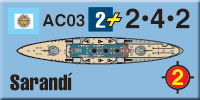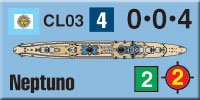| Tropical Storm:
Argentina & Chile
By Mike Bennighof, Ph.D.
April 2020
 Our alternative history game Second Great War at Sea: Tropic of Capricorn, posits a naval war that never happened: Argentina and Chile, aided by Britain, facing off against Brazil, aided by Germany. It’s part of our world-wide Second Great War alternative history, in which the First World War ended in December 1916 (two years earlier than in our own history) and war returned in 1940. Our alternative history game Second Great War at Sea: Tropic of Capricorn, posits a naval war that never happened: Argentina and Chile, aided by Britain, facing off against Brazil, aided by Germany. It’s part of our world-wide Second Great War alternative history, in which the First World War ended in December 1916 (two years earlier than in our own history) and war returned in 1940.
Argentina remained neutral during most of the actual Second World War, showing a distinct sympathy for the Axis cause but finally - after threats of Brazilian attack - declaring war on Germany in March 1945 as the war ground to a close. The war proved profitable for Argentina, thanks to robust sales of beef and grain to Britain.
In our Second Great War alternative history, the trade war that soured Anglo-Argentine relations in the late 1920’s does not take place, and Argentina has close commercial ties with the British Empire and close political ties with Fascist Italy. That draws Argentina into the war alongside the Allies, opposed to Germany’s ally Brazil.
The Argentine fleet that appears in Tropic of Capricorn draws heavily on Italian designs, with the larger warships built in Italian yards. In Second Great War at Sea: Tropical Storm the Argentines receive a few more Italian-built units; let’s have a look at them.
The Ancient Mariners

The Washington Naval Limitations agreement allowed Italy to keep the four pre-dreadnoughts of the Regina Elena class in service, and that’s true under the corresponding Vienna agreements of our Second Great War alternative history as well. In our story these ships were rebuilt during the 1930’s as armored cruisers, without the armament or protection to fight against battleships or even larger coast defense ships, and without the speed to get away from enemy cruisers.
The Royal Italian Navy considered the project a failure and a waste of resources, but this was fairly routine for the corrupt corporate state. The well-connected, including shipyards and arms makers, fed at the trough while the remainder were lectured for having “made bad choices.” Profit having been taken and dividends paid, the Navy was left to figure out what to do with four marginally-useful warships.
The answer was to sell two of them to Argentina. Roma and Napoli had been extensively reconstructed in the early 1930’s, with their old-style triple-expansion engines replaced by modern turbines, their two 305mm main guns replaced with the same 320mm guns arming the rebuilt older battleships, and new Model 1927 203mm guns replacing those in the wing turrets.
Powerful new machinery promised to deliver 30 knots, but in practice no amount of horsepower could drive their outmoded hull forms at better than 27 knots. Rebuilding could add deck armor, new underwater protection and more plate over the machinery spaces and magazines, but the defensive scheme remained that sketched at the turn of the century. These “armored cruisers” did not have the same protection as newly-built ships.
After the first year of the Second Great War, the Royal Italian Navy had lost two of the four units and no longer deployed the remaining pair in the Mediterranean. They served only on the first leg of the vital convoy routes between Europe and Argentina, and when the Argentines asked to buy additional heavy ships the Italians offered these for sale. Somewhat surprisingly the Argentines took them, allowing the Italian crews to be assigned to more useful ships.
Fast Cruisers

In the autumn of 1939 the Royal Italian Navy ordered a dozen cruisers of the Capitani Romani class, small and exceptionally fast ships designed as fleet scouts and “destroyers of destroyers.” By the time they were laid down the first mission had been given over to aircraft, and the Italians fought few surface actions in the Mediterranean involving destroyers. Few of them were even completed before Italy’s war came to a close.
That’s not the situation in the world of the Second Great War. Aircraft are far less developed than in our own history, and much less capable of taking on the same role in reconnaissance. When the Italians lay down their dozen cruisers, five more are begun for Argentina. The Argentine ships commission in late 1941, just in time to deploy to Argentina along with the newly-purchased armored cruisers for the southern hemisphere’s summer campaigns.
The Hércules class, as they’re known in Argentine service, are the fastest ships in the Armada and in the theater, clocking an astonishing 41 knots. They carry eight 135mm (5.3-inch) dual-purpose guns in four twin mounts and eight torpedo tubes. The Italian cruisers did not need excessive range, and their Argentine sisters have been modified with additional fuel stowage.
Chilean Addition

Despite their long-standing rivalry, Chile and Argentina both fight on the Allied side in the Second Great War, due to their close ties to Britain. Most of Chile’s fleet arrives to aid the Argentines, though not without inter-allied tensions. Chile adds just one new ship in Tropical Storm, the modern Italian-built coast defense ship Venganza.
Ansaldo drafted the design to Swedish requirements, a big ship displacing 17,500 tons and carrying six 280mm (11-inch) guns in three twin turrets. She had good speed and sufficient protection to ward off shells from similar weapons (such as the 280mm guns carried by German armored cruisers and battle cruisers and 305mm guns of the aging Soviet battleships).
The Swedes ultimately did not purchase the design, which would have been built in Swedish yards. In the world of the Second Great War it’s become a popular export design for Ansaldo, built in Ansaldo’s shipyards for Montenegro, Argentina, Portugal and Spain and under license in Sweden and Russia. Chile had a strong relationship with Ansaldo, and in our alternative history has purchased the fast commerce-raiding armored cruiser proposed by Ansaldo but never built in our own reality. A purchase of a pair of the coast-defense ships therefore follows standing practice. Only one of them enters the campaign in Tropical Storm, with the other retained at home.
And those are the new Argentine and Chilean ships of Tropical Storm. Next time, we’ll look at the Brazilians.
You can order Tropical Storm right here.
Sign up for our newsletter right here. Your info will never be sold or transferred; we'll just use it to update you on new games and new offers. Mike Bennighof is president of Avalanche Press and holds a doctorate in history from Emory University. A Fulbright Scholar and NASA Journalist in Space finalist, he has published over 100 books, games and articles on historical subjects.
He lives in Birmingham, Alabama with his wife, three children and his dog, Leopold. |
